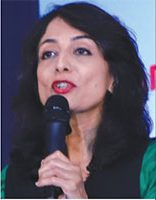
-Anjum Babukhan
Every parent and educator ponders over these questions: How can our children get smarter? What is that we can do to stimulate brilliance within our children and boost their creativity and critical thinking skills? If we believe the brain is the body’s central processing unit, then brain compatible learning (BCL) may be the solution to expand children’s learning bandwidth.
Neuron hub. Despite rapid and mind-boggling technological advancements and the advent of artificial intelligence, nothing can compete with the dynamism of the human brain. The brain is the crown jewel and CPU of the human body that differentiates homo sapiens from all other animal species. It’s incredible that we can think about our own thinking. Thanks to the neurosciences, we can learn about how we learn.
Brain-compatible learning (BCL) is an impressive interdisciplinary science that combines psychology, neuroscience and education. BCL influences not just pedagogy but educators to integrate information technology, art and physical education to boost the learning outcomes of students. The science of how the brain learns best is a revolution which has the potential to transform teaching-learning around the world.
Right ‘software’ for digital natives. How do we effectively teach GenXers who are continuously and mesmerisingly engaged with digital gadgets? Beginning from early childhood, children are exposed to digital stimuli and find it difficult to engage with old school pedagogies preferred by digital immigrants (i.e, parents and teachers). In this scenario, it is a huge challenge for an adult teacher or parent to compete with multi-media stimulators, gaming and instant feedback loops. How do we effectively engage a digital native in school or at home? How do we use the same hardware (students’ minds) but offer a different, more updated programme for learning (software)?
Built-in native capability. Given changing teaching-learning dynamics, educators and parents are becoming aware that hard research, backed with science equips us with the intellectual wherewithal to buttress best practices, especially the ones we knew worked, but were hard to prove. Through BCL we can make the new 3R’s — research, reflection and renewal — fundamental to learning and as important as the old school 3Rs (reading, ’riting & ’rithmetic). When educators and parents shift to using brain stimulating pedagogies backed by neuroscience research and validity, everyone benefits, especially children/students.
Processing information flow. Learning occurs across multiple brain pathways that receive and coordinate simultaneous inputs. The human brain processes sights, sounds, smells, tastes, and tactile sensations all at once. Experiences that engage all of the physical senses — walking through a museum or practicing a new skill or art, visiting a novel event — stimulate the growth of numerous dendrites and enhance learning by association.
Technically or more accurately electro-chemically, information transfer occurs through cell (neurons) transfer.
Neurons that fire together, wire together! When stimulated, brain cells grow branch-like extensions known as dendrites which have extended legs called axons that subdivide and connect to other dendrites. Therefore, sensorial experiences, emotional connections and motor movements help to embed information in various neural pathways that can be collectively retrieved to create what is commonly known as knowledge.
Memory capacity and retrieval. The great scientist Albert Einstein remarked that “knowledge is experience, everything else is information”. The brain’s structure alters with every experience. This phenomenon is known as neuroplasticity. How many neural connections are formed depends on both nature and nurture (genes and enrichment received from the environment). The brain receives millions of bits of information every second but it only retains a small fraction. Long-term memory stores only information it finds meaningful to connect to an existing schema (a developed circuitory) that is emotionally engaging or stimulating, new, or interesting enough to find its way into episodic memory (an unforgettable vivid episode).
Continuous BCL upgrade. “Brain-friendly teachers plan for learning by helping students branch out knowledge, provide an enriching and stimulating environment, and make learning meaningfully relevant,” says Eric Jensen, author of Brain-Compatible Strategies (2004).
It may sound jargon-like but simply put, BCL happens best when a learning environment, curriculum, pedagogy and psychological dynamics are designed and executed in ways that complement and accelerate functioning of the brain to acquire knowledge.
(Anjum Babukhan is co-founder of the Glendale Group of Institutions, Hyderabad and author of ABCs of Brain Compatible Learning (2016). Excerpted from keynote address delivered at the 10th Education-World Early Childhood Education National Conference 2020)
Also Read:Harsh parenting harms children’s brain development



























